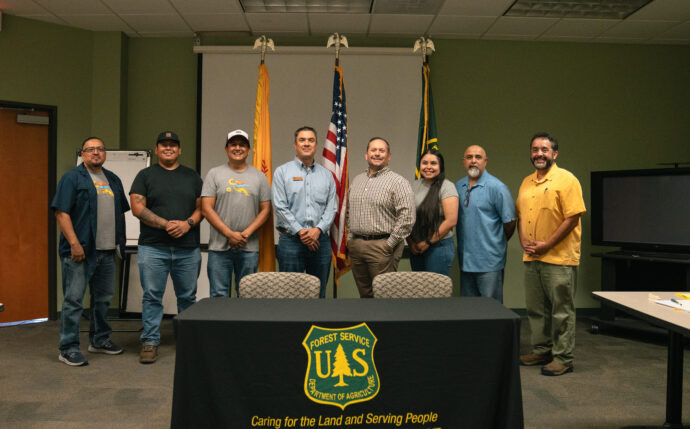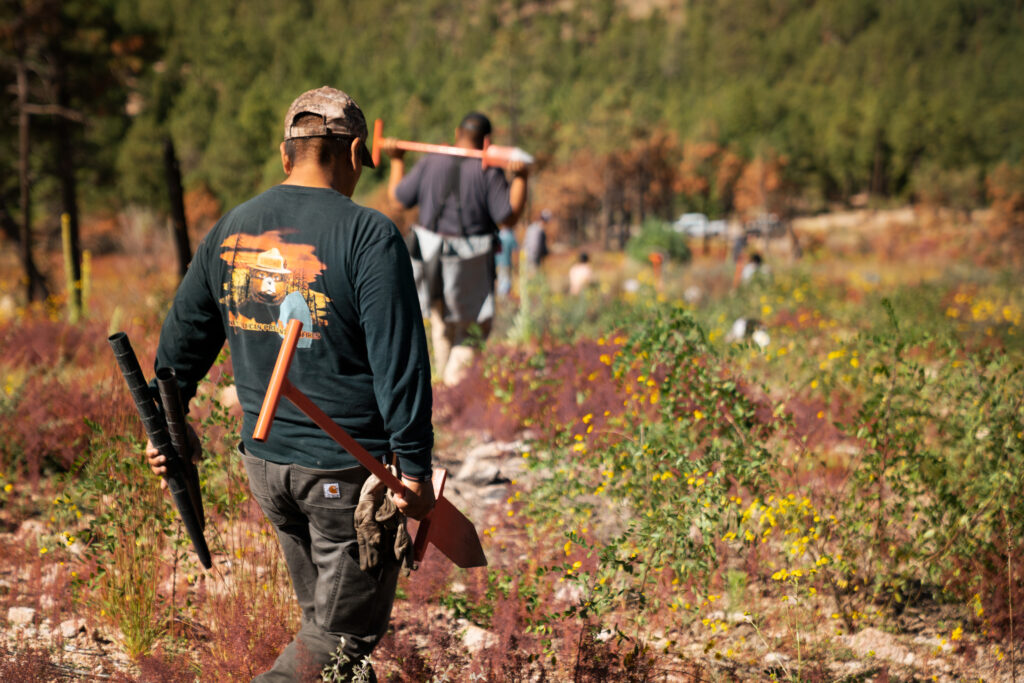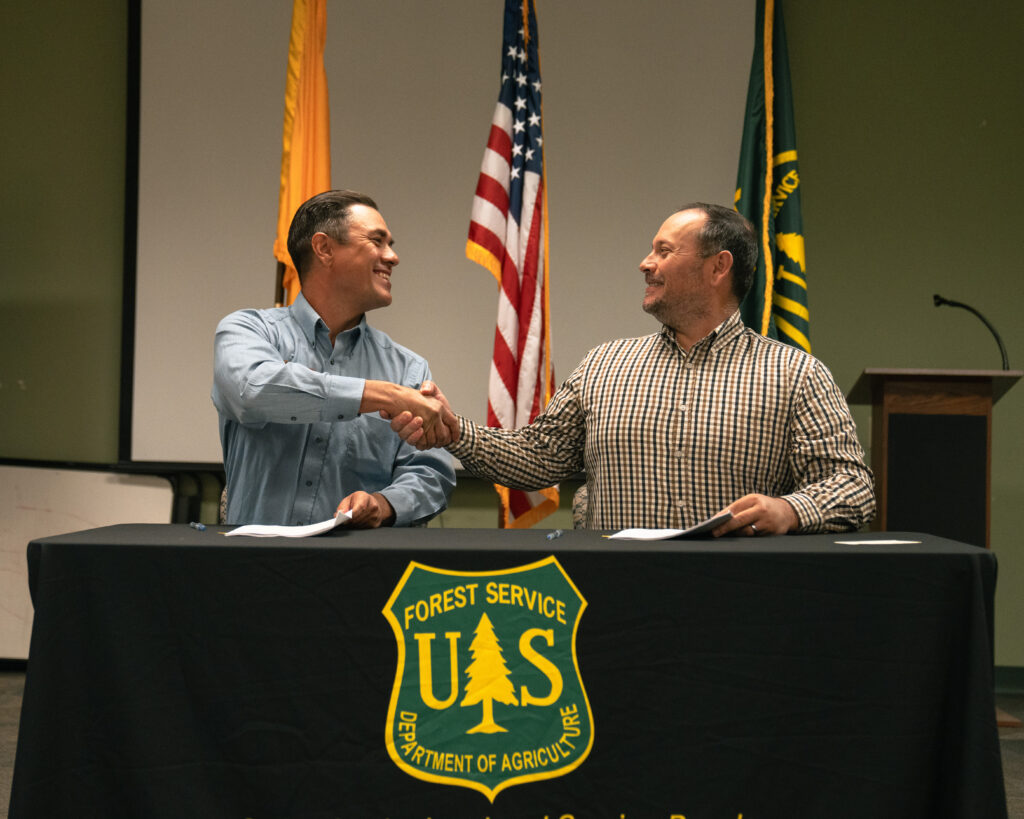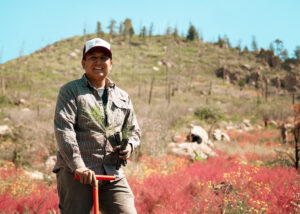
Catalyzing new opportunities in the Jemez Mountains: Reflections on the Tri-Pueblo Coalition’s successful efforts to gain co-stewardship access on ancestral lands
James Calabaza, Trees, Water & People“We all come from different backgrounds, different knowledge systems, different communities. But climate change doesn’t see differences. Fire and drought don’t see differences. We’re hoping that we can set aside our differences as people and focus on the need at this moment – restoring and stewarding landscapes for everyone’s benefit.”

Jemez Pueblo Forest Restoration Site.
The Jemez Ranger District of Santa Fe National Forest (SFNF) encompasses roughly 240,000 acres of public lands—and the ancestral lands of the Native Pueblos within Northern New Mexico. Historically, federal land management agreements for ancestral (public) lands have largely excluded Tribal engagement and expertise, but recent agreements between Trees, Water & People (TWP) and SFNF point towards new possibilities of co-stewardship.
For the past five years, TWP has collaborated with the Tri-Pueblo Coalition (TPC), an inter-Tribal coalition comprised of the Cochiti, Kewa, and Jemez Pueblos, to carry out post-fire restoration and promote Tribal-led stewardship within the Jemez range. The Coalition began conversations in 2019 with regional partners to explore opportunities for collaborating on these efforts across public/private designations. Tribes identified stewardship of the broader landscape—including ancestral lands within SFNF management—as a priority, but lacked administrative capacity and resources to facilitate a federal agreement. While conversations continued, the 2022 Cerro Pelado wildfire spread across Tribal and ancestral (public) lands, burning nearly 37,000 acres within SFNF and further deepening Tribes’ need to steward across management boundaries.
“We are the only species on this planet that sees boundaries, that sees lines, you know? Fire doesn’t see it, flooding doesn’t see it, animals don’t see it. And so, with post-fire recovery, there was an even stronger sense of the importance of establishing an agreement with the Forest Service, especially within the Santa Fe National Forest.”

Michael Martinez of TWP at Forest Restoration site.
In the same year, the Tri-Pueblo Coalition received a Catalyst Fund grant award, which offered support in laying the groundwork for a future agreement. The Catalyst Fund award enabled TWP to act as a liaison between the Coalition and SFNF representatives, reducing the administrative burden upon Tribal partners while working to ensure an agreement would meet the needs of all involved. After more than a year of discussing, developing, and building out an agreement, the vision became a reality.
On July 24th, 2024, Trees, Water & People signed two agreements with the Santa Fe National Forest, formally establishing Tribes’ access to co-stewardship of ancestral lands within the Jemez Ranger District. The first agreement is a non-cash cost share agreement which formalizes partnership between TWP and SFNF to work collaboratively on critical post-fire restoration and climate resiliency projects in the area. The second agreement will allocate $125,000 in Indian Youth Service Corps funds from the Forest Service, awarded to TWP and the Tri-Pueblo Coalition through a competitive process in April. These funds will be used by TWP, alongside Tribal partners, to plan and implement reforestation activities with Native youth from TPC communities and the Ancestral Lands Conservation Corps.
TWP’s unique role as a nonprofit convener of these agreements provides a win-win for SFNF, Tribes, and Jemez landscapes. The agreements contribute to SFNF’s efforts towards Tribal collaboration and strengthen their capacity to carry out restoration activities, informed by Tribal Ecological Knowledge (TEK), within disturbed landscapes. Though the government has often been seen as the only revenue source for restoration works on public lands, a formal partnership with TWP facilitates investment from philanthropic groups and the broader community.
“We’re all dependent on those resources – whether water, timber, or hunting, etc. – so more and more people are eager to support these types of efforts. It just takes one catalyzing group or organization to spearhead these opportunities and open doors for agreements to take place.”

Jemez Pueblo Department of Natural Resources at Reforestation Site
For Trees, Water & People, though, the north star of these efforts is providing back ancestral rights of the Tri-Pueblo Coalition to steward their ancestral lands. The agreements facilitate direct Tribal involvement in SFNF management decisions and restoration while positioning TWP to support Tribes in organizing and mobilizing funding stewardship activities. A nonprofit organization engaging in agreements on Tribes’ behalf is unique and unprecedented; while Tribes hold crucial ecological knowledge and connection to their ancestral lands and land management agencies are increasingly interested in integrating these knowledges – funding, time and capacity are often a barrier to implementation of agreements that support co-stewardship. In developing and signing the agreements, TWP will take on the administrative burden and risk, but continuously provide support and technical assistance for stewardship access and funding avenues to the Tri-Pueblo Coalition. Ultimately, the collaboration will allow the TPC to scale up their restoration efforts and expand their reach to more Native American Pueblo communities in New Mexico. Agreements like these can be a crucial foundation for reintegrating TEK in management of the ancestral (public) lands upon which we all depend. Engaging TEK, though, is not only about connecting knowledge to landscapes – it’s about connecting people.
“In the Santa Fe area, where there’s a high concentration of Tribal communities and peoples, no one has ever taken this position before, and I think that’s why we are willing to share this story. Hopefully it creates a model that can then be replicated across different parts of the country, or globally, of how NGOs can take on this role of support.”

Executive Director of TWP Sebastian Africano and SFNF Forest Supervisor Shaun Sanchez at agreement signing event.
The restoration and protection of critical landscapes will require a diversity of knowledges, a commitment to honest collaboration, and a willingness to listen. Though so many of us now define landscapes by boundaries, we believe healthy relationships can help us work within—and across—such boundaries. The hope of both the Tri-Pueblo Coalition and TWP is that this is just the beginning of what could be a very long-term, healthy collaborative that truly integrates different knowledge systems, communities, and dynamics for a more sustainable approach to stewardship.

Quotes throughout this piece are the words of James Calabaza, Director of the Indigenous Lands Program at Trees, Water & People (TWP). Born and raised in Kewa Pueblo, New Mexico, James holds unique experience working with Tribes, building trust, and upholding traditional landscape conservation values. In his role with TWP, James provides coordination support to Tribal groups throughout the United States, including the Tri-Pueblo Coalition.
